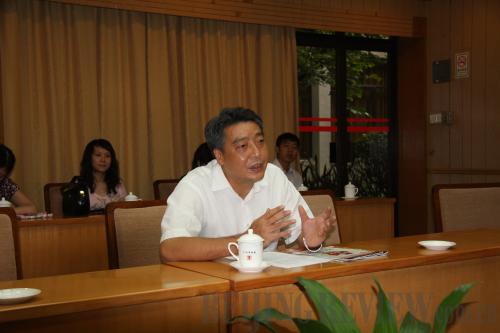|
 |
|
Guangzhou Vice Mayor Xu Ruisheng (DING WENLEI) |
Environmental concerns
Xu, a former architect before becoming vice mayor of Guangzhou in 2003, encouraged the use of Lingnan-style architecture in the design work for the Asian Games' venues. Lingnan-style architecture, widespread in Guangdong Province and Guangxi Zhuang Autonomous Region (south China), is known for its gorgeous and heavy decorations, compact layout and design suiting the humid local climate.
"Because the window designs maximize the use of natural light and airflow, much of the traditional architecture is actually low-carbon," Xu said. "Venues built with such designs for the games can host daytime sports events without extra lighting."
Xu also said GAGOC promoted the use of energy-efficient technologies in these venues. Wastewater will be recycled and water-cooling solutions will be introduced to utilize heat from the Pearl River in the Asian Games Town, a cluster of venues, press centers, athlete village and other service facilities. Low-carbon construction materials were also used in the new venues.
While choosing designers for the venues, GAGOC didn't court big name architects from around the world, but instead offered young, local designers the opportunity to demonstrate their talent and creativity.
Design work for the Asian Games Town was a joint-project between China and the United States, but much of the work was done by domestic architects in their 30s and 40s, who won out in the international biddings for venue design.
Independent marketing
Using the 2008 Beijing Olympics as a blueprint, the 16th Asian Games will serve as another of China's independent marketing for a large sports event.
The OCA signed an agreement with GAGOC on February 1, 2008, allowing Guangzhou to become the first host city to buy out exclusive marketing rights for the Asian Games.
So far, it's proven to be a "good bargain," with revenues expected to hit record highs, Xu Ruisheng said.
Japanese advertising giant Dentsu was the sole marketer and broadcaster for the previous three Asiads in Bangkok of Thailand, Busan of Korea, and Doha of Qatar.
"It's hard for the host city to have freedom in marketing when the sole agent wants half or one third of the profits from the market development," he said.
In the meantime, the financial crisis of late 2008 has posed a challenge for GAGOC's ability to successfully market the games. But GAGOC has an experienced and diligent team--nearly 50 staff members worked for the Beijing Organizing Committee for the Games of the XXIX Olympiad.
"Thanks to participation from state-owned and private enterprises, we have signed 47 sponsorship contracts," Xu said, adding that time at the table with potential sponsors is never time lost.
Taiwan Beer, which holds more than 70 percent of market shares of the Taiwan market, was named the official beer partner of the 16th Asian Games. "It will serve as an example of successful interactions between two markets across the Taiwan Straits, especially if the event helps boost its sales and recognition among mainland customers," said Xu. n
Guangzhou Facts
Guangzhou is the capital city of Guangdong Province in south China. It is now home to a considerable number of Africans – estimated to be 100,000 in number as of November 2009 – have moved to the city to do business and pursue their dreams.
As China has opened to the outside world over the past three decades, a large number of people from other regions around the country have flocked to Guangzhou, one of the first open cities nationwide. This has accelerated its economic development.
In 2009, total foreign trade in Guangzhou was valued at $76.74 billion, and foreign direct investment firms totaled 9,250. By the end of last year, 170 of the world's top 500 global companies had established a presence in the city, bringing in investment valued at $16.16 billion.
Source: www.guangzhou.gov.cn
www.gzstats.gov.cn |